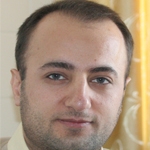EDITORIAL BOARD MEMBERS

Department of Pharmaceutical & Administrative Science
Western New England University
United States
BIOGRAPHY:
Biography
Dr. Priefer performed his doctoral work at McGill University in Montreal, Canada focused on organic and polymer chemistry. He next had the opportunity to work in two industrial settings, Starks Associate and Neurochem Inc. This expanded his repertoire into medicinal chemistry as well as industrial GLP requirements. Prior to joining the College of Pharmacy at Western New England University last July as a Full Professor, he had spent seven years in the Chemistry and Biochemistry Department at Niagara University, being promoted to Associate after only 4 years, and Full, 3 years hence; as well as become Chair of the Department. While at Niagara University, and now Western New England University, he has expanded his range of projects to also include analytical and materials chemistry. He has over 30 journal publications ranging from organic synthesis, physical organic, analytical, medicinal, educational, and material chemistry. He also is the pioneering investigator of the recently introduce a new class of polyelectrolytes into the realm of multilayer (i.e. pseudo-polyelectrolytes) which has made inroads in detection technology for Diabetes and Alzheimer’s as well as Proton Exchange Membranes.
Research Interests
SMALL MOLECULE DESIGN FOR THE DISRUPTION OF AMYLOID PLAQUE FORMATION
Alzheimers Disease (AD) is a devastating neurological degenerative disease that affected 4.5 million Americans in 2000, but is predicated to rise to 13.2 million by 2050. Causes of AD are general classified into three areas; 1) hyperphosphorylation of Tau, 2) insulin insensitivity, and 3) accumulation of the beta-amyloid (A-beta) peptide. The most prevalent theory is the Amyloid Cascade Hypothesis. It is postulated that when the APP protein is digested, initially with beta-secretase followed by gamma-secretase, the A-beta fragment is formed. This leads to aggregation of amyloid beta-peptide oligomers, also known as amyloid beta-derivatived diffusible ligands (ADDLs). These oligomers further congregate to form the characteristic plaques of AD patients.
There are four main areas for which a drug could possibly be designed to stop the progression of AD. They are i) beta-secretase inhibitors; ii) gamma-secretase inhibitors; iii) clearance or iv) prevention of A-beta monomer aggregation. This latter approach is the thrust of this research. We have synthesized libraries of molecules and have already begun testing using Thioflavine T fluorescence assay. One particular library has already yielded very promising results. Of the compounds tested within this set, three showed fibrillogenic inhibition between 70-85% after incubation of 3½ days.The remaining three compounds of this library demonstrated inhibition of ~95%.
MULTILAYER
Polyvinylphenol based polymers are weak polyacids due to the hydroxyl group attached to the phenyl ring. The aromatic character, very weak acidity, and hydrogen bonding capability of 4-vinylphenol and derivatives will yield polyelectrolytes with a rich suite of chemical and physical properties that are much different than most weak polyanions. Multilayered films of the phenol-based polymers have been prepared using the layer-by-layer assembly technique. The counter polycations investigated include polyallylamine, PDMAC, polyaniline and derivatives. The film growth has been followed using UV-visible spectroscopy, while their thickness, roughness, swelling, and morphology will be investigated using atomic force microscopy and Interference Microscope. The combination of aromaticity, hydrogen bonding, and variable charge density is expected to produce films with unique bulk and surface properties. This technology is being used for the development of new Proton Exchange Membranes, Breathalyzer for monitoring diabetes, and Detector of Abeta for Alzheimers Disease
NEW ANTIMICROBIAL AGENTS
The development of new antibiotics has become increasingly important as more and more strains of drug-resistant bacteria are being discovered. It is well known that phenol and many of its derivatives are antimicrobial agents. However, a comprehensive study of the structure-activity-relationship (SAR) has not been undertaken. Our research is to initial examine how modification of the acidity and lipophilicity of phenol derivatives alters biological activity to ultimately elucidate a SAR profile. This will provide a foundation to synthesize additional derivatives to further increase biological activity.
TYPE II DIABETES
Diabetes is a disease that affects 18.2 million Americans. Approximately 90-95% of these cases are type II diabetes. It has been found that this disease is directly linked to an over activity of protein tyrosine phosphatase 1B (PTP1B), which dephosphorylates the multiple tyrosine residues within the insulin receptor (IR) protein. Our research project is to develop a library of compounds which may act as inhibitors towards PTP1B.
PHOTODYNAMIC CANCER THERAPY
Photodynamic therapy (PDT) is a very attractive technique for the treatment of cancer as it is a non-invasive procedure. This involves the use of a photosensitive compound, which in the presence of light and oxygen can induce cellular death. PDT has been known for well over one hundred years, but is just now starting to be researched more extensively and used in clinical settings.
Work has been done using a boron core in a non-porphyrin based PDT agent (aza-BODIPY) with promising results. We are further examining this approach and evaluate whether these agents are active in PDT, show minimal dark toxicity, and can lead the cell to death via apoptosis. When irradiated above 600nm these aza-BODIPY compounds react with triplet O2 in the body to form a reactive singlet oxygen species which leads to cell death. In vitro studies on HeLa cells have revealed an effective photosensitive compound with low dark cytotoxicity and promotion of apoptotic cell death when exposed to light.
OTHER EDITORIAL BOARD MEMBER
Associate Vice President of Global Medical Development
College of Pharmacy & Morsani College of Medicine
University of South Florida
United States
Western University of Health Sciences
College of Pharmacy
United States
Department of Physiology and Pharmacology
Sapienza University of Rome
Italy
Pharmaceutical Sciences & Biomedical Engineering
University of Tennessee Health Science Center
United States
Department of Pharmaceutical Sciences
Albany College of Pharmacy and Health Sciences
United States
Department of Pharmacology
University of Toledo
United States
Graduate Institute of Natural Products
Chang Gung University of Science and Technology
Taiwan
School of Health Sciences
Macao Polytechnic Institute
Macau
Department of Pharmaceutical Chemistry, School of Pharmacy
The University of Kansas
United States
Department of Clinical Pharmacology
Dalian Medical University
China
Department of Pharmaceutics
School of Pharmacy
Fudan University
China
Department of Clinical Pharmacy
School of Pharmacy, Fudan University
China
Faculty of Sciences and Techniques Errachidia
Moulay Ismail University
Morocco
Kayyali Chair for Pharmaceutical Industries
Department of Pharmaceutics
king Saud University
Saudi Arabia
Department of Physiology & Pharmacology
Center for Cardiovascular and Respiratory Sciences
West Virginia University
United States
Department of Pharmaceutics
Tabriz University of Medical Sciences
Iran
Deputy Head of Drug Analysis & Pharmacokinetics Core
National University of Singapore
Department of Pharmacology and Experimental Neuroscience
Department of Pharmaceutical Sciences, Univeristy of Nebraska Medical Center
United States
Miller School of Medicine
University of Miami
United States
Department of Natural Sciences
Kathmandu University
Nepal
Department of Pharmacy
University of Naples Federico II
Italy
Department of Pharmacy
The University of Manitoba
Canada
Fellow Faculty of Pharmacy
Universiti Teknologi MARA (UiTM)
Malaysia
School of Pharmacy
Taylor's University
Malaysia
Department of Pharmaceutics
Roland Institute of Pharmaceutical sciences
India
Department of Pharmaceutics
Rayat -Bahra University
India
University Institute of Chemical Technology
North Maharashtra University
India
Associate Professor
Department of Pharmacology
Rajendra Institute of Technology & Sciences
India
Department of Pharmacology
Junagadh Agricultural University
India




















